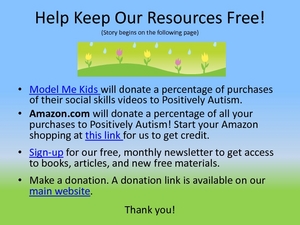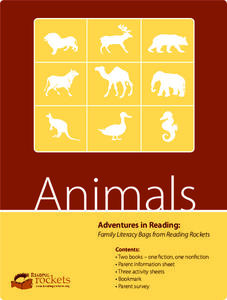Curated OER
Baby Elephant Orphans Get New Home, Families
Students react to a series of statements about elephants, then read a news article about how workers at an elephant orphanage are working to return the animals to the wild. In the animal studies and current events lesson, the teacher...
Curated OER
Travis the Train: Spring Time Animals
Tag along with Travis the Train as he encounters various baby animals that live on the farm. The spring time story introduces special-needs or autistic children to the types of plants and animals found on farms, each animal is identified...
Curated OER
Farm Animals-Cows, Pigs, Horses
Here is a good instructional activity for kindergartners that combines technology, literature, and art. In it, learners take a close look at some famous farm animals. They make the sounds that each animals makes, they use the internet to...
Curated OER
Classification of Animals
This is one of the better presentations I've seen on the classification of animals. Youngsters view slides that introduce the characteristics of each of the animals groups through the use of photographs and text. Then, they are given...
PBS
Reading Adventure Pack: Animals
Scholars explore the animal kingdom with help from two texts, Blueberries for Sal by Robert McCloskey and A Bed for the Winter by Karen Wallace. The literature and informational text set the learning stage for thoughtful discussion and...
Curated OER
Animal Adults and Babies
Students examine how different animals care for their young and how young animals change as they grow. They conduct research on the growth patterns and life cycle of a selected animal, create a realistic baby and adult form of their...
Curated OER
Help the Mommy Animal Find Her Babies
In this language arts activity, learners learn the names of mother animals and the babies by examining 4 sets of pictures. Using the word bank, students write the names by the pictures of the big and little animals. Then learners trace...
Curated OER
My Farm Animals
In this interactive animal science instructional activity, students type in the names of the 27 farm animals and choose the correct animal sound for each animal from the drop down menu. Students also complete six true or false questions...
Alabama Learning Exchange
Nocturnal Animals Lesson #4: Owls
Students investigate the owl food chain. They discuss owl facts, explore various websites, dissect an owl pellet, create a picture of the owl food chain, read the book, "Owl Babies," and write an owl poem.
Curated OER
Disney's Animal World Part 2: That's My Baby
Students see that baby animals go through different stages of growth during their life, just as people do. They use the downloadable Cyberinstructional activity Worksheet to reinforce what they have learned about animals and their...
Curated OER
Does It Move On It's Own?
Young scientists look at drawings of six animals, then match up a word that describes how they move. The words are: hop, crawl, swim, fly, run, and jump. They also answer two additional questions about the animals and how they move. A...
Curated OER
Zoo-Goers Ready to Greet Baby Panda
The Smithsonian's National Zoo, also known as the Washington Zoo, is one of the oldest zoos in the United States. Youngsters read and discuss a news article about Tai Shan, baby panda that was one of the zoos most famous residents. They...
Curated OER
Outside Animals Crossword Puzzle
In this outside animals worksheet, students explore all the possible animals that live outside in the wilderness and their habitats and then find the answers to fifty questions associated with those animals in a crossword puzzle.
Curated OER
Rock-a-bye Babies in a Wetland
Learners review the way human babies grow and what type of care they need. Using the internet, they are introduced to five different wetland habitat animals and how their babies grow. They discover how they are born and what the...
Curated OER
Farm Animals - Mothers and Babies - "Are You My Baby?"
Students listen to a teacher read aloud and discuss the farm animals. They participate in an role playing activity that explains how mother mammals recognize their young by their scent.
Curated OER
Junie B.'s Barnyard Babies
In this barnyard babies worksheet, students match the names of farm animals with their babies. Students write the sound that each animal makes. This is related to the Junie B. Jones series.
Curated OER
Favorite Farm Animals
Students perform a study of farm animals and their babies. They compile a graph of their favorite farm animals. They utilize a spreadsheet worksheet which is imbedded in this plan.
Curated OER
Beanie Baby Biographies
Learners write a biography for their favorite Beanie Babies and then share their biography out loud. A simple, yet effective idea! Everyone loves their Beanie Baby!
Curated OER
Animals A to Z: Koala
In this koala instructional activity, 3rd graders will add pages to their "animal books." Students will read 10 facts about a koala locating 10 errors of punctuation, capitalization, spelling, and grammar while working toward gaining an...
Curated OER
Animal Mommies and Babies
Looking for an ESL worksheet on animals? In this one, learners complete mazes helping the mommy animal find her babies. They write the names of the mommy animals and baby animals next to their pictures. A chart is included with the...
Curated OER
We've Come a Long Way, Baby!
Students study technology and the different reproductive technologies available today. In this human reproductive technology instructional activity students describe how engineers create technologies to improve the health of mothers and...
Curated OER
Form and Observation
Use a familiar song and adorable baby animal pictures to teach youngsters about genetic variation. Begin by listening to "Twelve Variations on 'Ah vous dirai-je Maman,'" which you will need to find online (there are several versions...
Curated OER
Animals versus Offspring Quiz
In this animals offspring worksheet, students choose the correct baby name for the animal in the picture. Students complete 24 multiple choice questions.
Curated OER
Animals Matching
Young learners match the names of adult animals with their babies' names. They draw lines to match ten adult and baby animals' names.

























